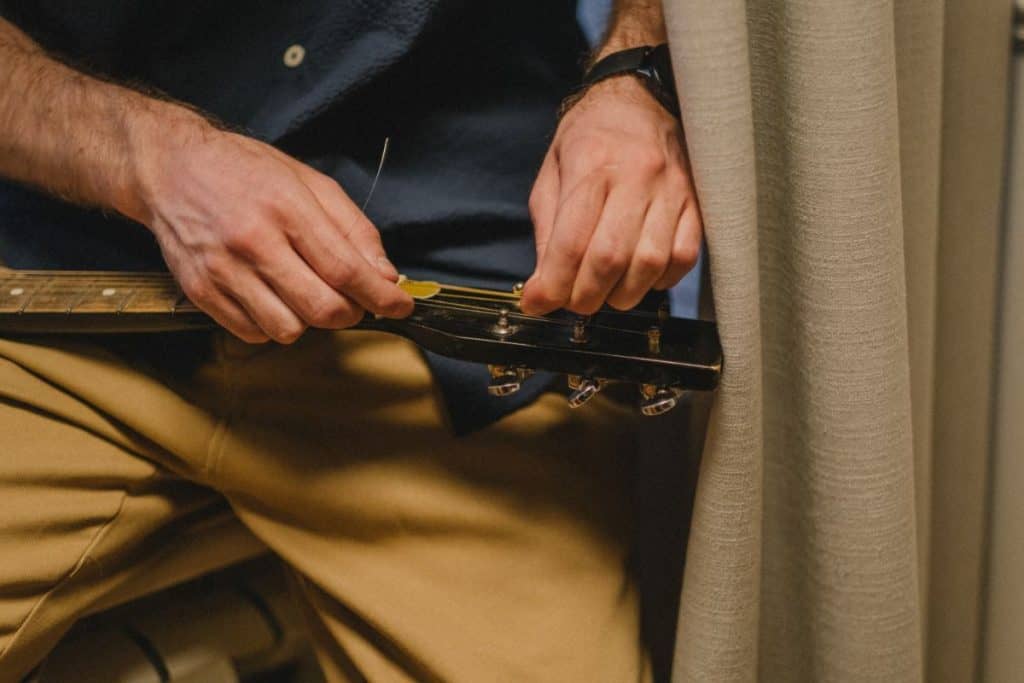Are your once bright, melodic strings now losing their tone? Are you struggling to hold tune when you play, or noticing a build-up of gunk or grim between your frets? It may be time to restring your guitar.

If intonation issues or weird vibration patterns are messing with your sound, it’s time to make a change. Thankfully, stringing a guitar isn’t as complex as it might seem.
With the help of a few simple tips and tricks, you can bring back your warm, vibrant tone in no time. So, amateurs and advanced players, listen up: here’s how to string a guitar.
When To Restring A Guitar
Is it time to restring your guitar? Here are a few signs it might be time to switch up your strings, swap out the blunts, and inject some new life into your tone.
You’re Not Holding Tune
Are you only able to make it through a few chords of your favorite song before your strings slip out of tune? We hate to break it to you, but this isn’t normal.
If your guitar is struggling to hold a tune, your strings are probably exhausted and in need of a replacement. This applies to you if your strings are falling out of tune when you’re not playing your guitar, too.
Your Strings Look Discolored
How do you tell if your strings are discolored? Well, take a close look at your headstock. If this seems darker than the rest of your strings, it might be time for a change.
Acoustic strings are usually a vibrant bronze or honey color. Electric strings are typically silver and shiny. If things are looking a little darker than usual, this is a sign that your strings are worn, and you’re probably due a fresh set.
‘Finger Fudge’
Yes, this is a thing. When you play your guitar regularly, you’ll naturally shed a charming collection of dead skin cells, oil, and dirt (yummy). We recommend cleaning your fretboard regularly to avoid this build-up, but we get it. It’s not always a priority.
If you’ve let your ‘finger fudge’ collect on your fretboard, it can leave your guitar looking grimy and gross. To clean up your build-up, it’s best to take off your strings, clean your fretboard, and throw on a fresh set of strings.
Things Sound Weird
If you’re anything like us, your guitar is your pride and joy. Even if you don’t play every day, you’ll have a firm idea of what your guitar sounds like.
If it’s sounding out of whack, vibrating a little too much, or generally sounding flat, you’re probably overdue for a string change.
How To String A Guitar

So, it’s time to give your guitar a little TLC and treat it to some new strings. But how do you change them? Follow our step-by-step guide below to learn how to string your guitar.
1. Slack Your Strings
Use your machine heads to slack your strings. You can do this by hand, but if you want to speed things up, use a manual or motorized string winder. When your strings are slack, cut them with a pair of wire cutters.
2: Remove String Pins
Now, pull your string pins out one by one and release the ball ends of the string from the bridge.
3. Clean Up The Machine Heads
By now, the majority of your strings should be off. However, you may still have a few loose ends wrapped around your machine heads. To remove these, use a pair of pliers. Be careful, though; these can be sharp – so watch your fingers!
4. Install New Strings
Now, it’s time to install your new strings. If you need to give your fretboard a clean, now’s the time to do it! We recommend using a lint-free cloth. Remember to check the material of your fretboard to choose the appropriate cleaner.
To install your new strings, start by threading the ball end through the hole on the bridge of your guitar. Then, push in the string pin. Remember: the groove should be pointing towards the neck.
5. Create Slack
Before tightening your strings, you’ll need to factor in some slack so there’s enough string to wrap around the tuner. You can do this by placing your hand upright halfway along the neck, and gently run the string over your hand.
6. Secure Strings
Now, you can start feeding and tightening. Thread the tail of the string around the tuner and tuck it beneath the string. Then, pull the tail tightly upwards. This will help keep your strings in place.
7. Wind On
Now, you’ll need to wind your strings on and secure them with a bit of tension. To do this, pull the string and keep the tail beneath the main part of the string.
Ensure each string is wound inside the machine head. On an acoustic guitar, you’ll need to turn your top three strings anti-clockwise, and the bottom three clockwise. Try and wind your strings at least four or five times around the tuner post.
8. Tune-Up
With your strings in place, grab your tuner and tune-up! We recommend taking it slow to avoid your string pins popping out of place.
Are Electric And Acoustic Guitars Strung Differently?
The process for stringing an electric and acoustic guitar is practically identical. However, your strings will look different. Electric guitar strings are generally thinner and have one less string that’s uncoated. Acoustic guitar strings are thicker.
Remember, the heads of each guitar are also anatomically different. However, this doesn’t change the technique needed to string your guitar.
The Bottom Line
There are many reasons why you might need to restring a guitar. Perhaps you’re overdue a string change, your strings aren’t holding tune, or your fretboard needs a wipe down.
Whatever the reason, changing your strings is a simple enough process that can be performed by beginners and advanced players alike. So, if you fancy a change, follow our guide above to bring your guitar back to life and enjoy playing again!
References
Recent Posts
QuickTime is a vital app for many Mac users, and if you’ve recently bought a new microphone, you might wonder how to use it optimally. QuickTime cannot record audio content if it doesn’t have...
Every microphone leaves a unique signature on the quality of its output. If you’re a podcaster trying to melt your way into your audience’s hearts, a muddy, distorted recording won’t cut it....
